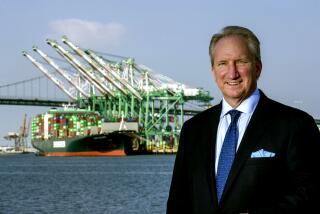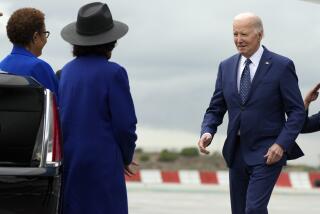Arcane Rule Has Cruise Ships Skirting U.S. Ports
- Share via
Bon voyage. You’ve been saving your pennies, and you’re ready to spend them on a luxury cruise from Southern California to Hawaii. Four hundred dollars per person per day? Fine. The Queen Elizabeth 2? Perfect.
And you’d want to begin, of course, with a flight from LAX to San Diego. Then a bus ride through Tijuana. Then an anxious wait on the Ensenada waterfront while wave-tossed tender boats shuttle between shore and the big ship, crew members hand-delivering fragile passengers from vessel to vessel between swells. . . .
What’s that? No?
Well, be forewarned. Because once you’ve decided to take a vacation on a big ship, you’ve entered the strangely American, yet un-American, domain of the cruise industry, and strange geographical rules apply.
It was one of those rules that lay behind the experience of Rena and Wesley Smith of Laguna Hills, who sailed on the QE2 from Ensenada to Lahaina, Maui, Jan. 18 to 23, but first endured the adventures above.
“Once we got on the ship, it was heaven,” Rena Smith says. But what, she asks, can we do about the troublesome government red tape that forced the entire Ensenada detour?
We can’t do much: It’s up to Congress, which has talked a great deal about this issue in recent years but has done nothing. Still, the Smiths’ adventures do offer a lesson in the law and the cruise industry.
The industry’s business is built on the patronage of U.S. citizens, its top officers are mostly Americans and it employs plenty of workers on U.S. soil. But the world’s leading cruise lines nevertheless remain largely offshore companies, their ships built abroad and registered in such countries as the Bahamas, Liberia and Panama.
This saves the cruise lines tens of millions of dollars yearly. They avoid most U.S. corporate taxes, for instance, and pay thousands of workers less than the federal minimum wage. All this, as the lines are quick to point out, results in lower fares than consumers would otherwise get.
But it also means the lines are barred from certain acts that would otherwise seem logical. Which brings us back to Ensenada.
The QE2 had to stop in Mexico between California and Hawaii because federal law bans foreign-flagged cruise ships from transporting American passengers from one U.S. port to another without a foreign stop in between. The law in question, written in 1886 to protect U.S. ferryboat operators on the Great Lakes from Canadian competitors, is the Passenger Services Act.
Ships that violate the law, even for safety reasons, risk fines of $200 per passenger, or more severe sanctions for repeat offenses, port officials say. (Another piece of maritime legislation, known as the Jones Act, applies similar restrictions to cargo shippers.)
Hence, despite a highly competitive marketplace, nobody offers a simple itinerary between New York and Florida, or Seattle and Alaska, or Florida and the U.S. Virgin Islands. Nor, as much as we consumers might like it, does any cruise line make return journeys between Los Angeles and San Diego or San Francisco or Seattle.
Instead, the ships typically sail from Los Angeles to Mexico, from Vancouver, Canada, to Alaska, or from Florida to just about any island that doesn’t fly the Stars and Stripes. (Still, the logistics of most cruises, including most QE2 cruises, are far simpler than those faced by Cunard’s LAX-San Diego-Ensenada-Hawaii passengers.)
Among more than 120 oceangoing overnight passenger ships serving the North American cruise market, industry experts say, just one sails under a U.S. flag: the Independence, which dates to the 1950s and sails among the Hawaiian islands under operation of American Hawaii Cruises. (American Hawaii Cruises’ parent company has announced plans to build a new U.S.-flagged passenger ship in the U.S.--the first in more than 40 years--but many in the industry view the project as a longshot.)
Given all this, is the cruise industry lobbying for changes in the Passenger Services Act to allow consecutive domestic stops? No.
Port officials (who hate the law) and waterfront labor leaders (who like it) have been skirmishing in Los Angeles, San Diego and elsewhere for years over whether this aged legislation should live or die. The U.S. House of Representatives has taken testimony on proposed reforms. Yet the cruise lines, perhaps wary of having a spotlight shone on the advantages of their un-American status (taxes, wages and so on), sit on the fence.
The International Council of Cruise Lines, a trade lobbying group in Washington, D.C., says reforming the law probably won’t help cruise lines “in light of the restrictions that likely would be attached.” But in any event, adds a spokeswoman, “we do not believe it would affect our itineraries one way or the other. . . . The itineraries that we have seem to make people happy.”
The North American cruise industry, which has grown from virtually nothing in 30 years, surpassed 5 million passengers for the first time in 1998. Trade forecasters project that between 1998 and 2002, cruise lines will unveil more than 40 new ships, increasing the industry’s passenger capacity by more than 40%.
But this bottom line remains: Unless you’re headed for a Mississippi steamboat or a Hawaiian float on the Independence, you can expect to find a foreign port on every cruise ship itinerary in North America.
Christopher Reynolds welcomes comments and suggestions, but cannot respond individually to letters and calls. Write Travel Insider, Los Angeles Times, Times Mirror Square, Los Angeles 90053, or send e-mail to [email protected].
More to Read
Sign up for The Wild
We’ll help you find the best places to hike, bike and run, as well as the perfect silent spots for meditation and yoga.
You may occasionally receive promotional content from the Los Angeles Times.







